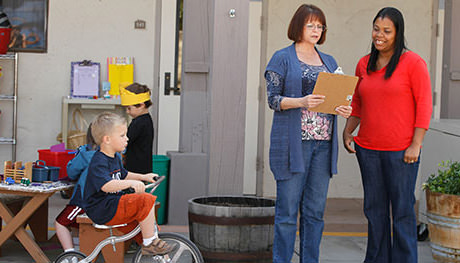Action is the test of what you know and can do. It is where you see the results of reflection and self-assessment. The CompSAT protocol, Keys to Reflection and Inquiry, is designed to help you formulate good questions, pursue inquiry, and take action to improve your daily practice. The results of your actions provide evidence of your professional growth, and hopefully, spur you on to generate more questions and take further action. Action and reflection are essential to the processes of growth and change.

While exploring the previous 5 Keys to Reflection and Inquiry, you have considered:
Use descriptive, accurate, and respectful language. For instance, the educators of Reggio Emilia use the phrases "children with special rights," instead of our phrasing, "children with special needs."
Write down all of the terminology you use or you have heard used to describe people with disabilities. After careful consideration, highlight the words or phrases that you think are descriptive (without judgment or bias), accurate, and respectful. Which do you consider derogatory or dismissive?
In your mind, what is the difference in meaning between these two phrases: "children with special rights," and "children with special needs”?
What messages do you think each of these phrases conveys to, and about, children, to families, and to the community?
Have a conversation with the other adults in your program. Consider together, and agree on, what language you will use to strengthen the view of children of all abilities.
You may want to read more about the power of words as related to this discussion. Search for articles by June Isaacson Kailes, Associate Director, Center for Disability Issues and the Health Professions, Western University of Health Sciences, Pomona, California.
"Incorporate issues specific to including people with disabilities and activity limitations into the culture, so that the issues are not viewed as "special" "sidebar" or "in addition to," but part of the daily radar screen of business as usual.
"Special needs" is a term that comes from outside of the disability communities. A significant element in the struggle for basic human rights is acknowledging and honoring what people call themselves. For example, "Negro" became "Black" and is now "African-American." "Indian" became "Native American," "ladies" and "girls" became "women," and "crippled" became "handicapped" and is now "disabled." Avoiding negative attitudes and stereotypes means neutralizing disability-specific terms. Disability-specific language should be precise, objective, and neutral to avoid reinforcing Negative values, biases and stereotypes. Language goes hand-in-hand with social change, both shaping it and reflecting it.
— Kailes, J. (1990). Language is more than a trivial concern. Paralyzed Veterans of America Bulletin, Virginia Chapter.
Linda Brault, the co-author of "Children with Challenging Behaviors: Strategies for Reflective Thinking," has a website that offers two downloadable resources, the BRAULT Behavior Checklist © and the Child by Activity Behavior Matrix.
Although the checklist has yes or no questions you can use it as a reflective prompt by adding "How" or "What" at the beginning of each question to make them open-ended.
Visit The Center for Inclusive Child Care and select a podcast about including all children in early childhood settings. After listening to the podcast, reflect on how the podcast reinforced or challenged my thinking about inclusion. Identify learning goals for children on which you can focus.
Use this template to record your observations, thoughts, and feelings. Download the Template
Deepen your understanding by checking out the Topic: Supporting children's understanding of disabilities or other special needs in Performance Area 2 in the CA ECE Competencies. Scroll to page 63.
Can you find other places in this competency area that address your interests and needs?

The new website for the California Map to Inclusive Child Care Project is operated by the Center for Child and Family Studies at WestEd, and funded by the California Department of Education Child Development Division. This comprehensive website is devoted to issue of inclusion and disabilities.
Read the "Reasons for Concern" brochure to help you see if your child's development is like that of other children the same age. To access the brochure in other languages, visit the State of California Department of Development Services web site.